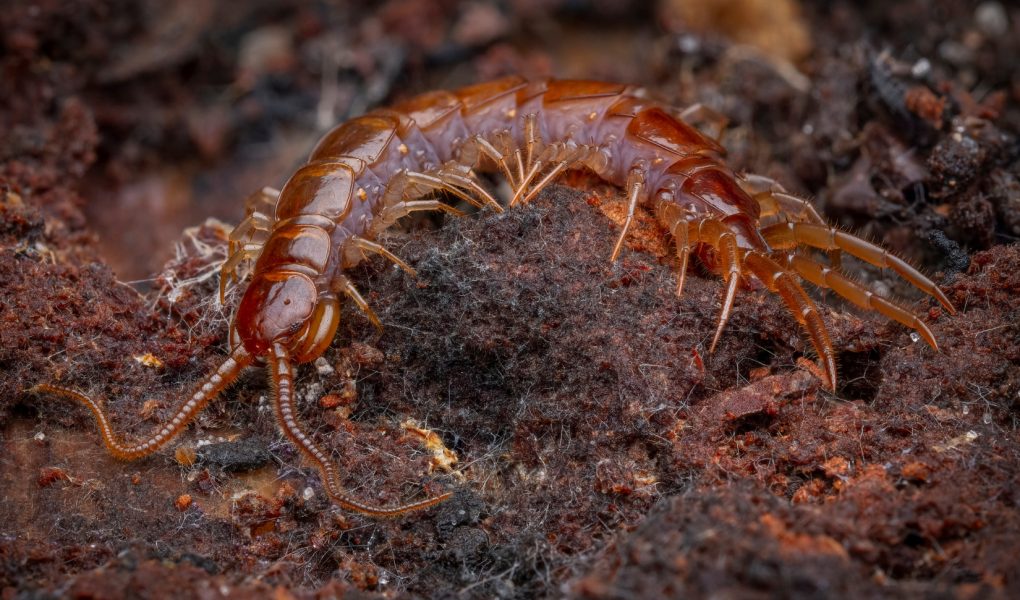kickstand-project.org – Centipedes, those elongated, multi-legged arthropods, are often encountered scurrying beneath rocks, logs, and leaf litter. While their name suggests “hundred legs,” the actual number varies between species. These fascinating creatures are active predators, playing a significant role in terrestrial ecosystems. This article explores the intricate world of centipedes, delving into their unique anatomy, hunting strategies, life cycle, ecological importance, and interactions with humans.
A Class of Many Legs: Chilopoda and its Orders
Centipedes belong to the class Chilopoda within the phylum Arthropoda. This class is divided into several orders, each with distinct characteristics:
- Scutigeromorpha (House Centipedes): Characterized by long, delicate legs and large compound eyes.
- Lithobiomorpha (Stone Centipedes): Smaller and more compact than house centipedes, with shorter legs.
- Scolopendromorpha (Tropical Centipedes): Often larger and more robust, including some of the largest centipede species.
- Geophilomorpha (Soil Centipedes): Slender and worm-like, adapted for burrowing in soil.
Physical Characteristics: Adapted for Predation and Rapid Movement
Centipedes possess several key physical adaptations:
- Segmented Body: Composed of multiple segments, each with one pair of legs (except for the first and last segments).
- One Pair of Legs per Segment: A defining characteristic of centipedes.
- Forcipules: Modified first pair of legs that form venomous claws used for capturing and paralyzing prey.
- Antennae: Sensory appendages used for detecting prey and navigating their environment.
- Tracheal System: A network of tubes for respiration.
Venom and Forcipules: Powerful Tools for Subduing Prey
Centipedes use their venomous forcipules to capture and subdue prey:
- Venom Glands: Located within the forcipules, producing a venom that varies in potency depending on the species.
- Paralysis and Prey Digestion: The venom quickly paralyzes prey, and some species inject digestive enzymes to begin breaking down the prey’s tissues.
While most centipede bites are painful to humans, only a few large tropical species pose a significant medical threat.
Habitat and Distribution: Thriving in Diverse Terrestrial Environments
Centipedes are found on every continent except Antarctica, inhabiting a wide range of terrestrial habitats:
- Forests and Woodlands: Living under bark, logs, and leaf litter.
- Grasslands and Deserts: Some species are adapted to drier environments.
- Caves and Underground Habitats: Certain species are troglobites (cave-dwelling).
- Urban Environments: Often found in gardens, basements, and other damp areas.
Behavior and Diet: Carnivorous Predators
Centipedes are active predators, primarily feeding on:
- Insects and Other Arthropods: Including spiders, worms, and other small invertebrates.
- Small Vertebrates: Larger species may prey on small amphibians, reptiles, and even small mammals.
They use their speed and agility to capture prey, relying on their venomous forcipules to subdue it quickly.
Reproduction and Life Cycle: From Egg to Adult
Centipede reproduction varies slightly between species:
- Direct Development: Young centipedes hatch resembling miniature adults.
- Molting: They undergo several molts as they grow, adding segments and legs with each molt.
- Maternal Care: Some species exhibit maternal care, with the female guarding the eggs and young.
Ecological Role: Important Predators and Decomposers
Centipedes play a crucial role in terrestrial ecosystems:
- Predator Control: They help regulate populations of insects and other invertebrates.
- Decomposers: Some species contribute to decomposition by feeding on decaying organic matter.
Centipedes and Humans: Generally Harmless but Sometimes Unwelcome
The relationship between humans and centipedes is generally one of indifference or mild aversion:
- Nuisance Pests: They can be considered nuisance pests when they enter homes, particularly damp basements.
- Painful Bites: While most bites are not medically significant, they can be painful.
- Beneficial Predators in Gardens: They can be beneficial in gardens by controlling insect pests.
Conservation Status and Threats: Generally Stable Populations
Most centipede species are not currently considered threatened, but they can be affected by:
- Habitat Loss and Degradation: Deforestation and habitat conversion can negatively impact local populations.
- Pesticide Use: Pesticides can directly harm centipedes or reduce their prey.
Conclusion: Understanding the Centipede’s Role in Nature
Centipedes, with their segmented bodies, numerous legs, and predatory lifestyle, are a fascinating and important part of terrestrial ecosystems. By understanding their unique adaptations, behaviors, and ecological roles, we can appreciate these often-misunderstood creatures and recognize their contribution to the natural world.




